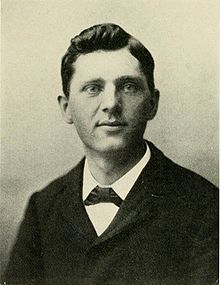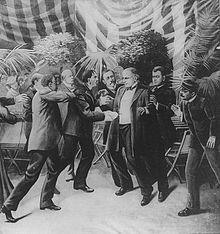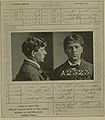- Leon Czolgosz
-
Leon Czolgosz 

Photo from 1900, found among Czolgosz's effects.Born May 1873[1]
Alpena, Michigan, USADied October 29, 1901 (aged 28)
Auburn, New York, USACharge(s) First-degree murder Penalty Death Status Executed by electric chair Occupation Steel worker Parents Mary (Nowak) and Paul Czolgosz[2] Leon Czolgosz (Polish pronunciation: [ˈt͡ʂɔlɡɔʂ]; May 1873[1] – October 29, 1901; also used surname "Nieman" and variations thereof)[3] was the assassin of U.S. President William McKinley.
In the last few years of his life, he claimed to have been heavily influenced by anarchists such as Emma Goldman and Alexander Berkman.
Contents
Early life
Czolgosz was born in Alpena, Michigan[4][page needed] in 1873, one of eight children (six boys and two girls)[5] of Mary (née Nowak) and Paul Czolgosz, Polish Catholic immigrants from Prussia.[2][6]
According to a different source, Czolgosz's ancestors were immigrants from what is now Belarus. His father might have emigrated to the US in the 1860s from Astravets near Hrodna. At immigration, he stated his ethnicity as Hungarian and changed his surname from Zholhus (Жолгусь, Żołguś) to Czolgosz.[7]
He was baptized in St. Albertus Catholic Church.[8][citation needed] His family moved to Detroit when he was five years old.
He left his family farm in Warrensville, Ohio, at the age of ten to work at the American Steel and Wire Company with two of his brothers. After the workers of his factory went on strike, he and his brothers were fired. Czolgosz then returned to the family farm in Warrensville. At the age of sixteen, he was sent to work in a glass factory in Natrona, Pennsylvania for two years before moving back home.[4][page needed][9][page needed]
Interest in anarchism
In 1898, after witnessing a series of similar strikes (many ending in violence), Czolgosz again returned home where he was constantly at odds with his stepmother and with his family's Roman Catholic beliefs. It was later recounted that through his life he had never shown any interest in friendship or romantic relationships, and was bullied throughout his childhood by peers.[4][page needed] He became a recluse and spent much of his time alone reading Socialist and anarchist newspapers while drinking milk in his mother's attic. He was impressed after hearing a speech by the political radical Emma Goldman, whom he met for the first time during one of her lectures in Cleveland in 1901. After the lecture Czolgosz approached the speakers' platform and asked for reading recommendations. A few days later he visited her home in Chicago and introduced himself as Nieman {No man}, but Goldman was on her way to the train station. He only had enough time to explain to her about his disappointment in Cleveland's socialists, and for Goldman to introduce him to her anarchist friends who were at the train station.[10] She later wrote a piece in defense of Czolgosz.[11]
The radical Free Society newspaper issued a warning pertaining to Czolgosz, reading:[12]
The attention of the comrades is called to another spy. He is well dressed, of medium height, rather narrow shoulders, blond and about 25 years of age. Up to the present he has made his appearance in Chicago and Cleveland. In the former place he remained but a short time, while in Cleveland he disappeared when the comrades had confirmed themselves of his identity and were on the point of exposing him. His demeanor is of the usual sort, pretending to be greatly interested in the cause, asking for names or soliciting aid for acts of contemplated violence. If this same individual makes his appearance elsewhere the comrades are warned in advance, and can act accordingly.Czolgosz believed there was a great injustice in American society, an inequality which allowed the wealthy to enrich themselves by exploiting the poor. He concluded that the reason for this was the structure of government itself. Then he learned of a European crime which changed his life: On July 29, 1900, King Umberto I of Italy had been shot dead by anarchist Gaetano Bresci. Bresci told the press that he had decided to take matters into his own hands for the sake of the common man.
The assassination shocked and galvanized the American anarchist movement, and Czolgosz is thought to have consciously imitated Bresci. New York police officer Joseph Petrosino believed that the same group had targeted President McKinley, but his warnings were useless, because McKinley ignored them.[13]
Assassination of President McKinley
 A sketch of Czolgosz shooting McKinley.
A sketch of Czolgosz shooting McKinley. Main article: Assassination of William McKinley
Main article: Assassination of William McKinleyOn August 31, 1901, Czolgosz moved to Buffalo, New York. There, he rented a room near the site of the Pan-American Exposition.[citation needed]
On September 6 he went to the exposition with a .32 caliber Iver-Johnson "Safety Automatic" revolver (serial #463344) he claimed he had purchased on September 2 for $4.50.[14] With the gun wrapped in a handkerchief in his pocket, Czolgosz approached McKinley's procession, the President having been standing in a receiving line inside of the Temple of Music, greeting the public for 10 minutes. At 4:07 p.m. Czolgosz reached the front of the line. McKinley extended his hand; Czolgosz slapped it aside and shot him in the abdomen twice at point blank range.
Members of the crowd immediately subdued Czolgosz, before the 4th Brigade, National Guard Signal Corps[4][page needed] and police intervened, and beat him so severely it was initially thought he might not live to stand trial.[15] Czolgosz was then briefly held in a cell at Buffalo's 13th Precinct house at 346 Austin Street until he was moved to the city's police headquarters downtown.
Trial and execution
Following the assassination, newly elevated President Theodore Roosevelt issued a pronouncement declaring: "When compared with the suppression of anarchy, every other question sinks into insignificance.”[16]
On September 13, the day before McKinley succumbed to his wounds, Czolgosz was transferred from the police headquarters, since the headquarters were undergoing repairs, to the Erie County Women's Penitentiary. On the 16th he was taken to the Erie County Jail before being arraigned before County Judge Emery. After the arraignment, he was transferred to Auburn State Prison.[4][page needed]
A grand jury indicted Czolgosz on September 16 with one count of first-degree murder. Throughout his incarceration, Czolgosz spoke freely with his guards, but refused every interaction with Robert C. Titus and Lorin L. Lewis, the prominent judges-turned-attorneys assigned to defend him, and with the expert psychiatrist sent to test his sanity.[17][page needed] A prison guard later came forward claiming that Czolgosz confided in him that because he claimed himself to be an anarchist, he would not talk with any people he viewed as related to authority which included his lawyers or any presiding trial judge.
The district attorney at trial was Thomas Penney, assisted by a Mr. Haller, whose performance was described as "flawless".[18] Although Czolgosz answered that he was pleading "Guilty", the presiding Judge Truman C. White overruled him and entered a "Not Guilty" plea on his behalf.[19]
In the nine days from McKinley's death on September 14, to Czolgosz's trial on September 23, Czolgosz's lawyers were unable to prepare a defense since Czolgosz refused to speak to either one of them. As a result, Lorin Lewis argued at the trial that Czolgosz could not be found guilty for the murder of the president because he was insane at the time (similar to the defense that was used in the Charles J. Guiteau trial in 1881, after the shooting of President James A. Garfield).
On September 23 and 24 prosecution testimony was presented, consisting of the doctors who treated McKinley and various eyewitnesses to the shooting. Lewis did not call any defense witnesses. Czolgosz himself refused to testify on his own defense, nor did he ever speak at all in court. In his statement to the jury, Lewis noted Czolgosz's refusal to talk to his lawyers or cooperate with them, admitted his client's guilt, and said that "the only question that can be discussed or considered in this case is... whether that act was that of a sane person. If it was, then the defendant is guilty of the murder... If it was the act of an insane man, then he is not guilty of murder but should be acquitted of that charge and would then be confined in a lunatic asylum."
The prosecutor laid great stress on Czolgosz's anarchist affiliations and called upon the jury to heed the popular demand for a quick trial and execution. Since the defense had been unable to enter any evidence that Czolgosz had been afflicted with any kind of temporary insanity, there could only be one verdict. Even if the jury believed the defense that Czolgosz was insane by claiming that no sane man would have shot and killed the president in such a public and blatant manner in which he knew he would be caught, there was still the legal definition of insanity to be overcome. Under New York law, Czolgosz was legally insane only if he was unable to understand what he was doing.[20]
At Thomas Penney's request, White closed the trial with instructions to the jury that supported the prosecution's argument that (a): Czolgosz was not insane, and that (b): he knew clearly what he was doing. After this, any chance that remained of acquitting Czolgosz on the basis of insanity was gone, since the defense offered no evidence that he couldn't understand the wrongness of his crime.
Czolgosz was convicted on September 24, 1901 after the jury deliberated for only one hour. On September 26, the jury unanimously recommended the death penalty. Czolgosz was said to have continued to remain silent and had shown no emotion upon both his conviction and death sentence. When he was asked by Judge White if he wanted to make any open court statement, Czolgosz shook his head meaning 'no'. Upon returning to Auburn Prison, Czolgosz asked the warden if this meant he would be transferred to Sing Sing to be electrocuted, and he seemed surprised to learn that Auburn had its own electric chair.[4][page needed]
Czolgosz was electrocuted by three jolts, each of 1800 volts, in Auburn Prison[21] on October 29, 1901.[22]
His brother, Waldek, and his brother-in-law, Frank Bandowski, were in attendance. When Waldek asked the Warden for his brother's body to be taken for proper burial, he was informed that he "would never be able to take it away" and that crowds of people would mob him.[4][page needed]
His last words were: "I killed the President because he was the enemy of the good people – the good working people. I am not sorry for my crime."[23][page needed] As the prison guards strapped him into the chair, however, he did say through clenched teeth, "I am only sorry I could not get to see my father."[23][page needed]
Czolgosz was autopsied by John T. Gerin;[24] his brain was autopsied by Edward Anthony Spitzka. The body was buried on prison grounds following the autopsy. Prison authorities originally planned to inter the body with quicklime to hasten its decomposition, but became dissatisfied with this option after testing quicklime on a sample of meat. After determining that they were not legally limited to the use of quicklime for the process, they poured sulfuric acid into Czolgosz's coffin so that his body would be completely disfigured.[25] The warden estimated the acid caused the body to disintegrate within 12 hours.[22]
Czolgosz's letters and clothes were burned, although in the case of letters the names of those who had sent threatening or sympathetic correspondence were recorded for future reference.[23][page needed]
Legacy
Emma Goldman was arrested on suspicion of being involved in the assassination, but was released, due to insufficient evidence. She later incurred a great deal of negative publicity when she published "The Tragedy at Buffalo". In the article, she compared Czolgosz to Marcus Junius Brutus, the killer of Julius Caesar, and called McKinley the "president of the money kings and trust magnates."[26] Other anarchists and radicals were unwilling to support Goldman's effort to aid Czolgosz, believing that he had harmed the movement.[27]
The scene of the crime, the Temple of Music, was demolished in November 1901, along with the rest of the Exposition grounds. A stone marker in the middle of Fordham Drive, a residential street in Buffalo, marks the approximate spot (42°56.321′N 78°52.416′W / 42.938683°N 78.8736°W[28]) where the shooting occurred . Czolgosz's revolver is on display in the Pan-American Exposition exhibit at the Buffalo and Erie County Historical Society in Buffalo.
Lloyd Vernon Briggs, who later became the Director of the Massachusetts Department for Mental Hygiene, reviewed the Czolgosz case in 1901 on behalf of Dr. Walter Channing shortly after Czolgosz's death.[29] Briggs also reviewed the cases of Clarence Richeson and Bertram G. Spencer, men who had histories of mental illness before committing murder. Contrary to views almost universally expressed at the time of the assassination, Briggs concluded that Czolgosz was "a diseased man, a man who had been suffering from some form of mental disease for years. He was not medically responsible and in the light of present-day psychiatry and of modern surgical procedure, there is a great question whether he was even legally responsible for the death of our President."
In Popular Culture
Comedian Patton Oswalt portrayed Czolgosz in a 2007 episode of the television series Reaper, aptly titled "Leon". This incarnation of Czolgosz, escaped from hell, possessed the ability to morph his hands into shotguns; an homage to the real Czolgosz' subterfuge during President McKinley's assassination.
Czolgosz is also featured as a central character of Stephen Sondheim's musical Assassins, in which his assassination of McKinnley is depicted in a musical number called "The Ballad of Czolgosz".
Gallery
-
Police mug shot of Leon Czolgosz #757.
See also
References
- ^ a b Twelfth Census of the United States, 1900; Orange, Cuyahoga, Ohio; roll T623 1261, page 4A, line 34, . Retrieved on 2008-09-10.
- ^ a b Rauchway 2004, pp. 114, 126.
- ^ Sarah Vowell, Assassination vacation, p. 214
- ^ a b c d e f g Briggs 1921.
- ^ Channing 1902.
- ^ Richardson 2003.
- ^ Президента США Уильяма МакКинли застрелил белорус?
- ^ "Leon Czolgosz — Wiki". UPI.com. 2011-06-14. http://www.upi.com/topic/Leon_Czolgosz/wiki/. Retrieved 2011-06-22.
- ^ Rauchway 2004.
- ^ Goldman 1931, pp. 289–290.
- ^ "Emma Goldman : Transcript". American Experience. PBS. 3-11-2004. http://www.pbs.org/wgbh/amex/goldman/filmmore/pt.html.
- ^ Everett 1901, Chapter 5
- ^ http://www.italyculturemonth.org/images/bookmark_09_GP_web.pdf
- ^ Leon Czolgosz and the Trial — "Lights out in the City of Light" — Anarchy and Assassination at the Pan-American Exposition
- ^ The Trial and Execution of Leon Czolgosz
- ^ Doherty 2011.
- ^ Andrews 1912.
- ^ Dr. McDonald's description of the trial
- ^ Hamilton, Dr. Allan McLane. "Autobiography". Pre-1921
- ^ Great American Trials 1994, pp. 225–227.
- ^ 1901 video of his execution
- ^ a b The Execution of Leon Czolgosz — "Lights Out in the City of Light" — Anarchy and Assassination at the Pan-American Exposition
- ^ a b c Seibert 2002.
- ^ Everett 1901, p. 448. "The physicians were: Dr. Carlos F. MacDonald of New York and Dr. Gerin of Auburn. Other witnesses were: E. Bonesteel, Troy; W. D. Wolff, Rochester; C. F. Rattigan, Auburn; George R. Peck, Auburn, N. Y.; W. N. Thayer, former warden of Dannemora prison, who assisted Warden Mead, and three newspaper correspondents."
- ^ "Assassin Czolgosz Is Executed At Auburn. He Declared that He Felt No Regret for His Crime. Autopsy Disclosed No. Mental Abnormalities. Body Buried in Acid in the Prison Cemetery". New York Times. October 30, 1901. http://select.nytimes.com/gst/abstract.html?res=F40613F63F5B11738DDDA90B94D8415B818CF1D3. Retrieved 2011-04-30. "At 7:12:30 o'clock this morning, Leon Frans Czolgosz, murderer of ... the formal finding in his case was composed as follows: Foreman, John P. Jaeckel. ..."
- ^ "The Tragedy at Buffalo"
- ^ Goldman 1931, pp. 311–319.
- ^ "Site of the Assassination of President McKinley". http://www.waymarking.com/waymarks/WM1MR2. Retrieved 30 July 2010.
- ^ Rauchway, p. 55.
- Cited sources
- Andrews, E. Benjamin (1912). History of the United States. six volumes. New York: Charles Scribner's Sons. http://books.google.com/books?id=GVZazgAACAAJ. Retrieved 2011-06-22.
- Briggs, L. Vernon (1921). The Manner of Man That Kills. http://www.archive.org/details/mannerofmanthatk00brig.
- Channing, Walter (1902). "The Mental Status of Czolgosz". American Journal of Insanity (American Psychiatric Association) 59 (2): 1–47.. ISSN 0002-953X.
- Doherty, Brian (January 2011). "The First War on Terror". Reason Magazine. ISSN 0048-6906. http://reason.com/archives/2010/12/17/the-first-war-on-terror/singlepage. Retrieved 2011-06-22. a review of The World That Never Was: A True Story of Dreamers, Schemers, Anarchists, and Secret Agents, by Alex Butterworth, Pantheon Books...
- Goldman, Emma (1931). Living My Life. New York: Alfred A. Knopf.
- "Leon Czolgosz Trial: 1901". Great American Trials. New England Publishing. 1994. pp. 225–227.
- Everett, Marshall (1901). Complete life of William McKinley and story of his assassination.
- Rauchway, Eric (2004). Murdering McKinley: The Making of Theodore Roosevelt's America (paperback ed.). Hill and Wang. ISBN 978-0-809-01638-9.
- Richardson, Heather Cox (2003-08-24). "A captivating tale of a murder that mattered, and why it did". Chicago Tribune: p. 7. ISSN 1085-6706. Archived from the original on 2003-08-24. http://rauchway.ucdavis.edu/chictrib.html. Retrieved 2011-06-22. a review of Rauchway's Murdering McKinley
- Seibert, Jeffrey W. (2002). I Done My Duty: The Complete Story of the Assassination of President McKinley (Illustrated ed.). Bowie, Md.: Heritage Books. ISBN 978-0-788-42118-1.
External links
- Film: Reenactment of the execution of Leon Czolgosz in the electric chair, early film from 1901, Library of Congress archives (.rm format; offline viewable)
- PBS biography of Czolgosz
- Leon Frank Czolgosz at Find A Grave
- Stone marker at assassination site
- Q&A interview with Scott Miller on The President and the Assassin, June 22, 2011
Categories:- 1873 births
- 1901 deaths
- 1901 crimes
- 20th-century executions by the United States
- American anarchists
- American people convicted of murder
- American people of Polish descent
- American people of Belarusian descent
- Anarchist assassins
- Executed American people
- Executed anarchists
- History of Buffalo, New York
- History of Cleveland, Ohio
- People executed by electric chair
- People executed by New York
- People convicted of murder by New York
- People from Alpena County, Michigan
- Assassins of United States presidents
- American assassins
Wikimedia Foundation. 2010.






